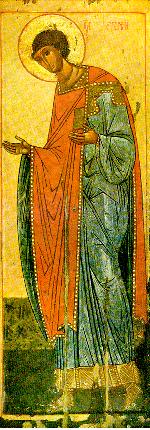
Novgorod School. About 1400.
The Amberg Collection. Koelliken, Switzerland. 177 x 64 cm. and 177 x 66 1/2 cm.


 These
two icons are monumental, very proportional and effectively composed within
narrow panels. Their colors are very harmonious and seem to be applied with
vigor, lightness and without much effort. The colors are accented with delicate
highlights. The drawing is exact and expressive. According to Ouspensky and
Lossky, "The calm and inner collectedness is rendered by the bend of the head
and the stoop of the shoulders. The postures are free and natural."
These
two icons are monumental, very proportional and effectively composed within
narrow panels. Their colors are very harmonious and seem to be applied with
vigor, lightness and without much effort. The colors are accented with delicate
highlights. The drawing is exact and expressive. According to Ouspensky and
Lossky, "The calm and inner collectedness is rendered by the bend of the head
and the stoop of the shoulders. The postures are free and natural."
St. Basil the Great is represented, as is usual for bishops, in full vestments with the attributes of his high office. Over his chasuble he wears an omophorion with crosses "by means of which the bishop symbolizes the incarnated Son of God." As a successor of the Apostles and a teacher of his Church, he holds in his left hand the Gospels, while his right hand is stretched in a gesture of prayer. . . St George is depicted in a red cloak, traditional for a martyr, and ample blue tunic with greenish reflection. The icons presented here are a part of the Deesis row in an iconostasis wall. The forms of the figures are outlined and the colors are brighter since they were meant to be seen from a distance. It is interesting to see how the movement is implied by the position of the legs and how the robes are rendered, with particular attention given to curves and lines. Saint George is depicted not in his most common iconography, on a horse, killing the dragon, but under more somber circumstances, as a martyr, demanded by his role as a part of the Deesis Row in an Iconostasis. Particular attention is devoted to details such as St. Basil's Bible and his robe. Both saints are rendered with one hand lifted in blessing, which is a recurrent element in icons. Their expression is severe and distant and their two-dimensionality separates them even more from the viewer. Although particular attention is given to the depictions of highlights and shadows, the figures appear two dimensional, which is an integral part of a successful traditional icon. [S.C.]
[Source: Ouspensky and Lossky].
